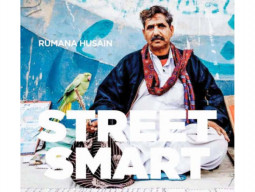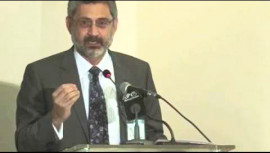
KARACHI: Time travel has not been made possible yet. Peerzada Salman’s Karachi — Legacies of Empires is probably the next best thing.
Turn over the hardback cover of this latest addition to coffee table books on Karachi and you will find all the ingredients to let you strike up a conversation on the city’s remarkable history told through its magnificent buildings. What started off as a regular column for Dawn, ‘Stone Age’, has become a comprehensive collection of the history and architectural design of the city’s buildings made from stone.
Read: Book launch: Rumana Husain brings together the street smart people of Karachi
Salman takes you on a journey that starts from Merewether Tower, which was designed among other things to “dominate the skyline of the city” and to make “the local people realise the importance of time”. The tower fails to perform both these tasks today but at least the edifice remains as a reminder of the end of the Mughal era in this port city.
The journey continues to the magnificent building of the Karachi Port Trust, the oft-visited Empress Market and the Hindu Gymkhana. Salman also uncovers hidden jewels of the colonial legacy, such as Mules Mansion, Bristol Hotel, Hormusji Katrak Hall and more. The book is divided into four sections: landmark buildings, roads and neighbourhoods, health recreation and places of worship. All the buildings serving these varied purposes have one thing in common: they are legacies of stone structures of an empire that once dominated the subcontinent.
Read: City of lights: Festival hopes to evoke memories of Karachi’s glory days
Fahim Siddiqui’s photos of the city’s architectural beauty is perhaps what makes this book a real journey through time. He has captured the eeriness of the Freemason Lodge and its imposing columns, and the sunlight filtering through the arches in Flagstaff House so well that it takes the viewer right behind his camera lens, actually able to hear the birds chirping outside the KPT building. Those choosing the cover for the book would have surely been spoilt for choice.
When he started writing ‘Stone Age’ in May 2009, Salman had anticipated his column would feature a mere 20 buildings in the city but his journey around the majestic buildings continues to this day. His narrations bring forth the contributions of Moses Somake, born in 1875 in Lahore to parents of Jewish extraction. What makes his works stand out is best described in the words of Salman: “The most wonderful aspect of discussing Somake is that at the time he was at work, Karachi was a tolerant city. Imagine the Portuguese Christian community asking a Jew to make a club for them. My team and I have recently discovered that even the Muslim community had commissioned Somake to design a mosque for them.”
It is, therefore, quite disappointing when Salman decides to quote Dr Akhtar Hameed Khan’s homage to the architect where there is an empty space where the promised Urdu couplet should have been.
It is fairly obvious the writer yearns for the Karachi of the past when the first chapter of the book is titled ‘Turn back the clock’. In fact, when he introduces II Chundrigar Road in the book he admits how the past is better than the future. “Welcome to Ibrahim Ismail Chundrigar Road. If you think it is still McLeod Road, you need to get back to the future, though it would not be as much fun.”
From the book cover to the way Salman captures the feel of the city’s heritage buildings, it is nostalgia for a city that we know to have been, in Sir Charles Napier’s words, “the glory of the East” and one that seems to be losing the grandeur that Napier promised he will return to see once again.
Published in The Express Tribune, July 5th, 2015.
Like Life & Style on Facebook, follow @ETLifeandStyle on Twitter for the latest in fashion, gossip and entertainment.





















1713418975-0/MehwishKhans-(1)1713418975-0-270x192.webp)


1712071304-0/image-(14)1712071304-0-270x192.webp)
















COMMENTS
Comments are moderated and generally will be posted if they are on-topic and not abusive.
For more information, please see our Comments FAQ